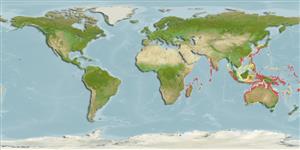>
Gobiiformes (Gobies) >
Gobiidae (Gobies) > Gobiinae
Etymology: Trimmatom: Greek, trimma, -atos = something crushed + Greek, tomos = cut (Ref. 45335).
More on author: Winterbottom.
Environment: milieu / climate zone / depth range / distribution range
นิเวศวิทยา
เกี่ยวกับทะเล,น้ำเค็ม เกี่ยวกับหินโสโครก; ระดับความลึก 0 - 28 m (Ref. 90102). Tropical
Indo-West Pacific: Seychelles, Cargados Carajos, Chagos Archipelago to Sumatra and the Philippines, north to Japan, south to Papua New Guinea, the Solomon Islands, and the Timor Sea.
ขนาด / น้ำหนัก / Age
Maturity: Lm ? range ? - ? cm
Max length : 2.2 cm TL เพศผู้/กระเทย; (Ref. 90102)
Short description
สัณฐานวิทยา | ความยาวต่างๆ
เงี่ยงครีบหลัง (รวม): 6; ก้านครีบอ่อนที่หาง (รวม): 9; ก้านครีบอ่อนที่ก้น: 9. Trimmatom pharus differs from T. nanus, T. offucius, and T. sagma in possessing scales on the body (vs naked) and branched pelvic fin rays (vs unbranched). Trimmatom zapotes, T. macropodus, and T. pharus all have body scales but T. zapotes has unbranched pelvic fin rays, and T. macropodus has the first four pelvic fin rays branched. Trimmatom pharus shares many meristic characteristics with T. eviotops including the presence of body scales and the branching of the first four pelvic fin rays; the two species do, however, differ in details of colour pattern. In preserved specimens the first body bar on T. eviotops crosses the pectoral base and the extends over the dorsum, passing backwards to the dorsal fin. In Trimmatom pharus the body bar which crosses the pectoral base crosses the dorsal surface anterior to the dorsal fin. Trimmatom eviotops has a broad dark saddle on the dorsall half of the caudal peduncle, while Trimmatom pharus has a narrow body bar or small dark saddle (Ref. 52310).
Inhabits shoals, reefs and lagoons in 0-28 m (Ref. 90102).
Life cycle and mating behavior
วัยเจริญพันธุ์ | การสืบพันธุ์ | การวางไข่ | เซลสืบพันธ์ของเพศเมีย(ไข่) | ความดกของไข่ | ตัวอ่อน
Winterbottom, R., 2001. Two new gobiid fish species in Trimma and Trimmatom (Teleostei: Gobiidae) from the Indian and Western Pacific Oceans. aqua, J. Ichthyol. Aquat. Biol. 5(1):19-24. (Ref. 52310)
IUCN Red List Status (Ref. 130435)
Threat to humans
Harmless
Human uses
ข้อมูลเพิ่มเติม
ชื่อสามัญชื่อพ้องกลไกการเผาผลาญพลังงานผู้ล่าการศึกษาเกี่ยวกับผลกระทบของสารประกอบทางเคมีที่เป็นอันตรายต่อสิ่งมีชีวิต ประชากร และสิ่งแวดล้อมการสืบพันธุ์วัยเจริญพันธุ์การวางไข่การรวมกลุ่มวางไข่ความดกของไข่เซลสืบพันธ์ของเพศเมีย(ไข่)Egg development
Age/SizeการเจริญเติบโตLength-weightLength-lengthLength-frequenciesความยาวต่างๆสัณฐานวิทยาตัวอ่อนพลวัตของสัตว์น้ำวัยอ่อนการทดแทนที่อุดมสมบรูณ์BRUVS
อ้างอิงการเพาะเลี้ยงสัตว์น้ำประวัติการเพาะเลี้ยงสัตว์น้ำสายพันธุ์พันธุศาสตร์ElectrophoresesอัตราพันธุกรรมโรคการแปรรูปNutrientsMass conversion
ผู้ร่วมมือรูปภาพหลายรูปStamps, Coins Misc.เสียงปลามีพิษ เช่น ปลาปักเป้าความเร็วรูปแบบการว่ายน้ำพื้นที่เหงือกOtolithsสมองวิสัยทัศน์
เครื่องมือ
Special reports
Download XML
แหล่งที่มาจากอินเตอร์เน็ต
Estimates based on models
Preferred temperature (Ref.
123201): 23.5 - 29.3, mean 28.2 °C (based on 2040 cells).
Phylogenetic diversity index (Ref.
82804): PD
50 = 0.5078 [Uniqueness, from 0.5 = low to 2.0 = high].
Bayesian length-weight: a=0.00708 (0.00333 - 0.01504), b=3.09 (2.92 - 3.26), in cm total length, based on LWR estimates for this (Sub)family-body shape (Ref.
93245).
ระดับชั้นอาหาร (Ref.
69278): 3.0 ±0.3 se; based on size and trophs of closest relatives
ความสามารถในการกลับคืนสู่ปกติ (Ref.
120179): ความสูง, เวลาต่ำสุดที่จะทำให้ประชากรเพิ่มขึ้นเป็น 2 เท่าใช้เวลาน้อยกว่า 15 เดือน (Preliminary K or Fecundity.).
Fishing Vulnerability (Ref.
59153): Low vulnerability (10 of 100).
